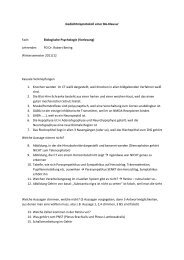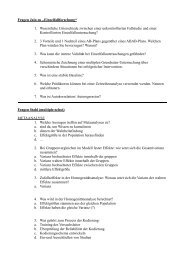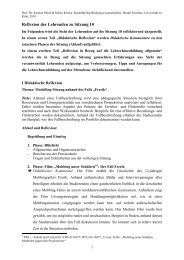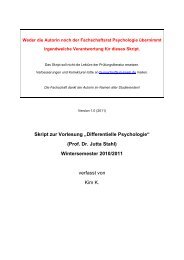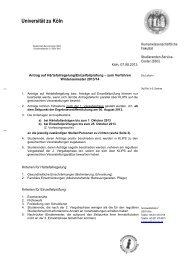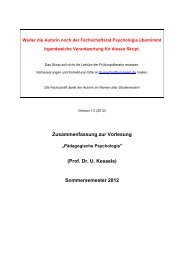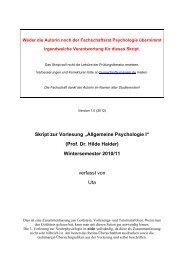«Geben Sie ihm doch einfach fünf Jahre!»
«Geben Sie ihm doch einfach fünf Jahre!»
«Geben Sie ihm doch einfach fünf Jahre!»
Erfolgreiche ePaper selbst erstellen
Machen Sie aus Ihren PDF Publikationen ein blätterbares Flipbook mit unserer einzigartigen Google optimierten e-Paper Software.
B. Englich: Zwischenrufer im Gerichtssaal 225<br />
International contributions (pp. 215–226). Berlin:<br />
Walter de Gruyter.<br />
Marti, M. W. & Wissler, R. L. (2000). Be careful what you<br />
ask for: The effects of anchors on personal injury damages<br />
awards. Journal of Experimental Psychology: Applied,<br />
6(2), 91–103.<br />
Mussweiler, T. & Englich, B. (in press). Subliminal anchoring:<br />
Judgmental consequences and underlying<br />
mechanisms. Organizational Behavior and Human<br />
Decision Processes.<br />
Mussweiler, T. & Strack, F. (1999a). Comparing is believing:<br />
A selective accessibility model of judgmental anchoring.<br />
In W. Stroebe & M. Hewstone (Eds.), European<br />
review of social psychology (Vol. 10,<br />
pp. 135–167)). Chichester, England: Wiley.<br />
Mussweiler, T. & Strack, F. (1999b). Hypothesis-consistent<br />
testing and semantic priming in the anchoring<br />
paradigm: A selective accessibility model. Journal of<br />
Experimental Social Psychology, 35, 136–164.<br />
Mussweiler, T. & Strack, F. (2000). The use of category<br />
and exemplar knowledge in the solution of anchoring<br />
tasks. Journal of Personality and Social Psychology,<br />
78, 1038–1052.<br />
Mussweiler, T., Strack, F. & Pfeiffer, T. (2000). Overcoming<br />
the inevitable anchoring effect: Considering the<br />
opposite compensates for selective accessibility. Personality<br />
and Social Psychology Bulletin, 26, 1142–<br />
1150.<br />
Nagel, S. (1962). Judicial backgrounds and criminal cases.<br />
Journal of Criminal Law, Criminology, and Political<br />
Science, 53, 333–339.<br />
Partridge, A. & Eldridge, W. B. (1974). The second circuit<br />
sentencing study. Washington D. C.: The Federal Judicial<br />
Center.<br />
Pollard, P. (1992). Judgments about victims and attackers<br />
in depicted rapes: A review. British Journal of Social<br />
Psychology, 31, 307–326.<br />
Pruitt, C. R. & Wilson, J. Q. (1983). A longitudinal study<br />
of the effect of race on sentencing. Law and Society<br />
Review, 17, 613–635.<br />
Schmid, J. & Fiedler, K. (1998). The backbone of closing<br />
speeches: The impact of prosecution versus defense<br />
language on judicial attributions. Journal of Applied<br />
Social Psychology, 28, 1140–1172.<br />
Schmid, J., Fiedler, K., Englich, B., Ehrenberger, T. &<br />
Semin, G. R. (1996). Taking sides with the defendant:<br />
Grammatical choice and the influence of implicit attributions<br />
in prosecution and defense speeches. International<br />
Journal of Psycholinguistics, 12, 127–148.<br />
Sorensen, J. R. & Wallace, D. H. (1995). Capital punishment<br />
in Missouri: Examining the issue of racial disparity.<br />
Behavioral Sciences and the Law, 13(1), 61–80.<br />
Strack, F. & Hannover, B. (1996). Awareness of influence<br />
as a precondition for implementing correctional goals.<br />
In P. Gollwitzer & J. Bargh (Eds.), The psychology of<br />
action: Linking cognition and motivation to behavior<br />
(pp. 579–596). New York: Guilford.<br />
Strack, F. & Mussweiler, T. (1997). Explaining the enigmatic<br />
anchoring effect: Mechanisms of selective accessibility.<br />
Journal of Personality and Social Psychology,<br />
73, 437–446.<br />
Trope, Y. & Liberman, A. (1996). Social hypothesis testing:<br />
Cognitive and motivational mechanisms. In E. T.<br />
Higgins & A. W. Kruglanski (Eds.), Social psychology:<br />
Handbook of basic principles (pp. 239–270). New<br />
York: Guilford.<br />
Tröndle, H. & Fischer, T. (2003). Strafgesetzbuch und Nebengesetze.<br />
51. Auflage. München: C. H.Beck.<br />
Tversky, A. & Kahneman, D. (1974). Judgment under uncertainty:<br />
Heuristics and biases. Science, 185, 1124–<br />
1131.<br />
Wegner, D. M. (1994). Ironic processes of mental control.<br />
Psychological Review, 101, 34–52.<br />
Wegner, D. M., Ansfield, M. & Pilloff, D. (1998). The Putt<br />
and the pendulum: Ironic effects of the mental control<br />
of action. Psychological Science, 9, 196–199.<br />
Wegner, D. M., Schneider, D. J., Carter, S. R., III & White,<br />
T. L. (1987). Paradoxical effects of thought suppression.<br />
Journal of Personality and Social Psychology,<br />
53, 5–13.<br />
Wilson, T. D. & Brekke, N. (1994). Mental contamination<br />
and mental correction: Unwanted influences on<br />
judgments and evaluations. Psychological Bulletin,<br />
116, 117–142.<br />
Wilson, T. D., Houston, C., Etling, K. M. & Brekke, N.<br />
(1996). A new look at anchoring effects: Basic anchoring<br />
and its antecedents. Journal of Experimental Psychology:<br />
General, 4, 387–402.<br />
Wong, K. F. E. & Kwong, J. Y. Y. (2000). Is 7300 m equal<br />
to 7.3 km? Same semantics but different anchoring effects.<br />
Organizational Behavior and Human Decision<br />
Processes, 82, 314–333.<br />
Birte Englich<br />
Universität Würzburg<br />
Lehrstuhl für Psychologie II<br />
Röntgenring 10<br />
D-97070 Würzburg<br />
Tel. +49 931 312161<br />
Fax +49 931 312812<br />
E-mail englich@psychologie.uni-wuerzburg.de<br />
ZFSP 36 (4) © 2005 by Verlag Hans Huber, Hogrefe AG, Bern




